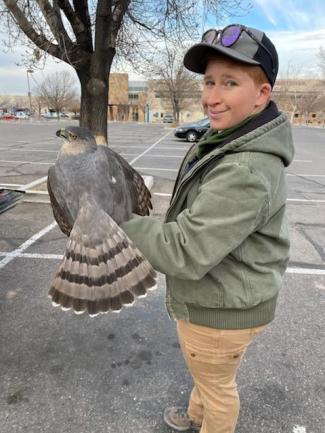Congratulations Ally Davidge for successfully defending your Master's Degreee Thises!
Ally has accepted a position with the US Forest Service as a District Wildlife Biologist in Pollick Pines, CA, and will be moving there during Winter Break.
Ally Davidge
Master’s Degree Candidate
Drs. Michael Wunder & Laurel Hartley’s Labs
When: Friday, Nov. 17th at 10:00a
Where: NC 1312
“Cooper’s Hawk Occupancy Across Socio-Economic Boundaries in Denver, Colorado”
As urban spaces expand, making persistent changes to ecosystem structure and function, it is vital to understand how wildlife use the urban environment to ensure measures that maximize biodiversity, mitigate human-wildlife conflict, and preserve ecosystem function are intentionally built into future urban planning and conservation. We don’t yet understand the mechanisms that underlie Cooper’s Hawk persistence in urban spaces, but socio-economically motivated changes are likely to impact the built environment and by extension, occupancy probability of Cooper’s Hawks which are a tertiary consumer used to indicate ecosystem health at lower trophic levels. We investigated to what degree redlining grade, as a proxy for socio-economic policies affects Cooper’s Hawk occupancy in Denver, Colorado. Redlining was the practice of identifying mortgage lending risk profiles for neighborhoods using resident identity criteria to decide where to invest limited dollars. This practice, at least in part, influenced the contemporary physical structure of the city. We sampled the presence/absence of Cooper’s Hawks across the four urban redlining grades (Best, Still Desirable, Definitely Declining, Hazardous) in the city to estimate hawk detection and occupancy probability. We also considered occupancy variables related to environmental structure and conspecific influence within core-use-areas around survey points including percent tree canopy cover, percent built area, NDVI, and distance to nearest known neighbor. The proportion of sites estimated to be occupied for Best, Still Desirable, Definitely Declining, and Hazardous are 0.39 (95% CI=0.23-0.58), 0.24 (95% CI=0.12-0.42), 0.03 (95% CI=0.00-0.19), and 0.12 (95% CI=0.04 -0.28) respectively. Using an AICc table, the top three most parsimonious models indicated that redlining grade captures some variation in Cooper’s Hawk occupancy that tree cover does not. We posit that, to more holistically predict urban wildlife distribution, models should consider socio-economic policy impacts and more work should be done to identify which urban landcover types matter most to Cooper’s Hawks.
Everyone is welcome to attend.

